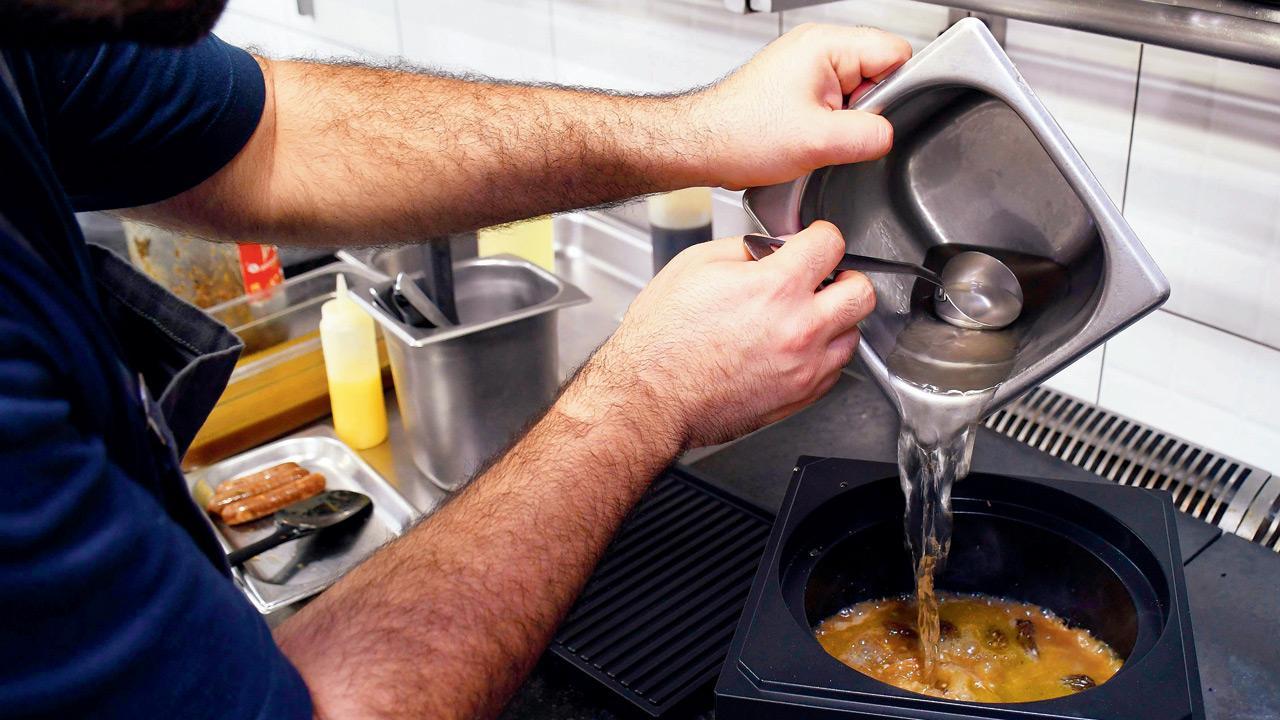A carbon graphite cooking tool from Japan is a one-stop pot for poaching, grilling, steaming and braising

Chef Prateek Sadhu of Masque restaurant cooking with ANAORI, a Japanese cooking equipment made of carbon graphite. Pics/Ashish Raje
What looks like a top-secret cuboid box that may protect a deathly secret sits on the kitchen top of Masque. Chef Prateek Sadhu lifts the square plate top, revealing a circular wooden lid made of Hinoki Japanese cypress that opens into deep-rounded bottomed cooking pot called Imogama, which means potato shaped. The cube is called ANAORI Kakugama, a cooking tool with superior heat retention that also rivals the far infrared emissivity achieved when cooking with charcoal. Made of carbon graphite, it emits five times more infrared than cast iron.
ADVERTISEMENT
“It has multi-purpose use and can go into the oven, used on the stove and the top lid even turns into a grill. One can make rice, braise a quail, roast a chicken in the oven and make sausages or veggies on the grill. Once it is hot, you can turn off your stove or oven and allow the heat to cook the ingredients inside,” Sadhu explains. The rounded bottom ensures equal distribution of heat. The equipment is now a permanent feature at the Masque Lab, a wilderness-to-table restaurant located in Mahalaxmi, which seats only 10-12 patrons at a time.
Guchhi pulao with rogan josh sausages. Made using the expensive guchhi mushrooms or morels, this flavorsome rice dish is from Kashmir
Sadhu makes us a guchhi pulao using the equipment. He cooks the rice without adding water in ghee, spices, and a morrel miso that has been fermenting in his kitchen since February. The equipment generates and retains five times more heat than a traditional pot, which efficiently cuts cooking time. “A no-frills-attached pot, it is easy to care for. All you need is a foam soap wash,” says Sadhu. The ANAORI Kakugama, which is priced at 3,200 dollars (approximately R2.35 lakh), is for home use too if you can afford it. “Cooking time is reduced and energy is saved,” says Sadhu.
Toru Okuda from Ginza Kojya, Japan, has used it to make takikomi-gohan (Japanese mixed rice)
In his home country, Toru Okuda from Ginza Kojya, Japan, has used it to make simmered abalone and vegetables, which took about two-third the time it normally takes. He also tried a takikomi-gohan (Japanese mixed rice).
“While the cooking time did not change for making rice, the water absorption process, which normally must be done before heating, was not necessary because the rice cooked well without it,” says Okuda.
Sadhu says the equipment generates and retains five times more heat than a traditional pot, which efficiently cuts cooking time
The pot has the same effect as cooking with charcoal, which is essential in Japanese cuisine. “The advantage of cooking with charcoal is that the ingredients can be cooked without placing any stress on them. This means that they are not heated from the outside, but from the inside of their tissues. This way, the ingredients can be cooked while retaining their proper moisture content and without destroying their tissues, thus drawing out their umami (flavour),” says Okuda.
It has multi-purpose use and can go into the oven, used on the stove and the top lid even turns into a grill
When chef Enrico Crippa of Piazza Duomo in Alba, Italy, first got his hands on the pot, he cooked a chickpeas ramen, a tribute to the origin of the pot. “Later, I made the salad of Vignaiolo, a traditional and old way to reuse the meat leftover from Sunday lunch, flavoured with green sauce, and generally consumed by the winery workers the day after, I elevated it with walnuts, hazelnuts, Raschera cheese and apples,” says Crippa, whose 3-Michelin star restaurant is also among the 50 best restaurants in the world.
Known for sourcing ingredients from his vegetable garden, he also used the pot to create his classic dish, the vegetable soup. “It has been fun to renew my recipes using the pot. Creativity is always a challenge, and when you open your kitchen to something new, it reveals new flavours. The innovation in kitchen tools brings curiosity and new ways of conceiving the dishes. The cypress lid gives an unmistakable flavour. I am impressed how the tool changes the aromas of the bollito [stew] we use in the salad of Vignaiolo,” he adds.
The first dish that chef Enrico Crippa of Piazza Duomo in Alba, Italy, cooked with the ANAORI was chickpeas ramen
The aroma of guchhi brings us back to the Masque kitchen. The entire process took less than 30 minutes from cooking the pulao in the pot and grilling the rogan josh sausages on the grill. “I’m thinking, it would be great to make payasam, sheera or halwa in this,” Sadhu thinks aloud. We dig our spoon into the pulao, and allow the flavours to take over. The umami lingers long after we have wiped the bowl clean.
 Subscribe today by clicking the link and stay updated with the latest news!" Click here!
Subscribe today by clicking the link and stay updated with the latest news!" Click here!






